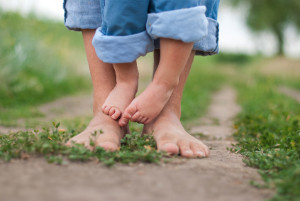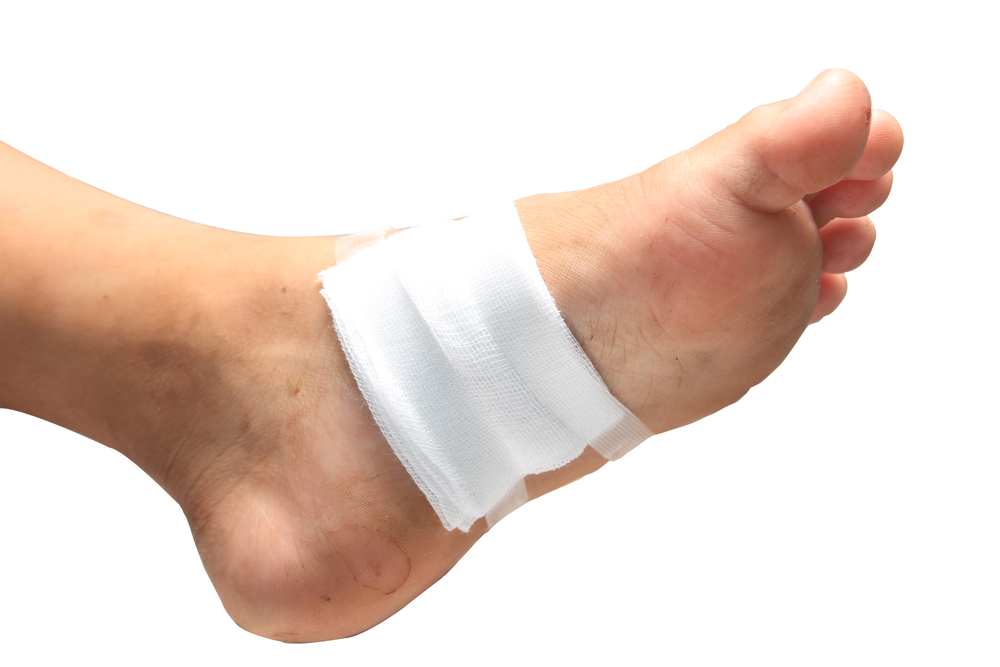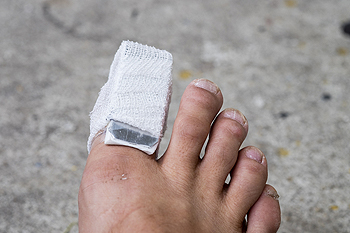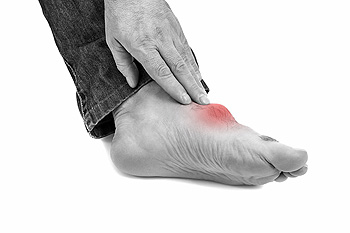Blog
How to Guide Your Baby to Their Best Foot Health
Your baby’s early foot development is important to their future health. You can help put them on the path to healthy feet as an adult with proper care now. Check their feet regularly for anything abnormal. To avoid ingrown toenails, trim toenails straight across—not rounded or too close to the skin. Give your toddler’s toes enough space to move and grow by keeping socks, footed pajamas and booties roomy. Let your baby go barefoot (supervised) during the day to exercise and strengthen their foot and toe muscles. Later, as they are learning to walk, being barefoot will help them grip the floor and figure out balance. Their first pair of shoes for outside walking should be flexible, lightweight, and fitted by a professional. If you notice anything unusual about your child’s feet, or are concerned about their development, schedule an appointment with a podiatrist for an examination.
The health of a child’s feet is vital to their overall well-being. If you have any questions regarding foot health, contact Elliot T. Udell, DPM of New York. Our doctor can provide the care you need to keep you pain-free and on your feet.
Tips for Keeping Children's Feet Healthy
- Make sure their shoes fit properly
- Look for any signs of in-toeing or out-toeing
- Check to see if they have Clubfoot (condition that affects your child’s foot and ankle, twisting the heel and toes inward) which is one of the most common nonmajor birth defects.
- Lightly cover your baby’s feet (Tight covers may keep your baby from moving their feet freely, and could prevent normal development)
- Allow your toddler to go shoeless (Shoes can be restricting for a young child’s foot)
- Cut toenails straight across to avoid ingrown toenails
- Keep your child’s foot clean and dry
- Cover cuts and scrapes. Wash any scratches with soap and water and cover them with a bandage until they’ve healed.
If you have any questions, please feel free to contact our office located in Hicksville, NY . We offer the newest diagnostic and treatment technologies for all your foot care needs.
How People with Diabetes Can Help Prevent Foot Wounds
Foot wounds are an unfortunate reality for many people with diabetes. Detecting and helping to prevent foot ulcers from occurring—and seeking treatment if they do—is extremely important for anyone with diabetes. Because diabetes can reduce circulation and feeling in the legs and feet, detecting a foot wound can be difficult. That’s why it’s important to examine your feet every day—particularly the bottom of the feet where ulcers can often develop. Early detection of cuts, cracks, sores, blisters or other changes in the skin can help prevent these minor abrasions from devolving into a wound. Foot wound prevention also includes wearing comfortable shoes that fit well, keeping your toenails trimmed straight across and not too short, and wearing compression socks that can help blood flow, and keep feet dry and bacteria-free while reducing pain and swelling. It is also suggested that people with diabetes seek the professional care of a podiatrist who can provide additional prevention measures—and treat any wounds if they do occur.
Wound care is an important part in dealing with diabetes. If you have diabetes and a foot wound or would like more information about wound care for diabetics, consult with Elliot T. Udell, DPM from New York. Our doctor will assess your condition and provide you with quality foot and ankle treatment.
What Is Wound Care?
Wound care is the practice of taking proper care of a wound. This can range from the smallest to the largest of wounds. While everyone can benefit from proper wound care, it is much more important for diabetics. Diabetics often suffer from poor blood circulation which causes wounds to heal much slower than they would in a non-diabetic.
What Is the Importance of Wound Care?
While it may not seem apparent with small ulcers on the foot, for diabetics, any size ulcer can become infected. Diabetics often also suffer from neuropathy, or nerve loss. This means they might not even feel when they have an ulcer on their foot. If the wound becomes severely infected, amputation may be necessary. Therefore, it is of the upmost importance to properly care for any and all foot wounds.
How to Care for Wounds
The best way to care for foot wounds is to prevent them. For diabetics, this means daily inspections of the feet for any signs of abnormalities or ulcers. It is also recommended to see a podiatrist several times a year for a foot inspection. If you do have an ulcer, run the wound under water to clear dirt from the wound; then apply antibiotic ointment to the wound and cover with a bandage. Bandages should be changed daily and keeping pressure off the wound is smart. It is advised to see a podiatrist, who can keep an eye on it.
If you have any questions, please feel free to contact our office located in Hicksville, NY . We offer the newest diagnostic and treatment technologies for all your foot care needs.
Gout Pain Can Be Managed
Effective Prevention Techniques May Help to Prevent Falling
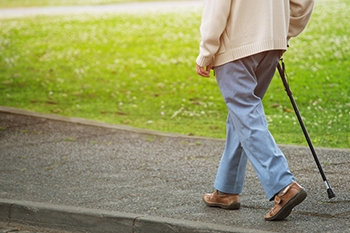 Research has indicated that elderly people may benefit from having assistive devices installed throughout the home. These can be helpful in preventing falls, which can cause serious injuries. Additionally, falling may invoke a loss of independence, as the fear of falling can precede everyday activities. Some of the safety measures that can be used in an elderly person’s household can include grab bars in the shower and toilet area, a non-slip bath mat, and improved lighting. Additionally, it may be beneficial to use a walker or cane while inside the home, and a stair lift may be needed for seniors that reside in a home with stairs. Falling can be debilitating to the feet and can cause accomplishing daily activities to temporarily cease. If you would like to know more information about how falling can affect the feet, and learn about effective preventive strategies, please speak with a podiatrist.
Research has indicated that elderly people may benefit from having assistive devices installed throughout the home. These can be helpful in preventing falls, which can cause serious injuries. Additionally, falling may invoke a loss of independence, as the fear of falling can precede everyday activities. Some of the safety measures that can be used in an elderly person’s household can include grab bars in the shower and toilet area, a non-slip bath mat, and improved lighting. Additionally, it may be beneficial to use a walker or cane while inside the home, and a stair lift may be needed for seniors that reside in a home with stairs. Falling can be debilitating to the feet and can cause accomplishing daily activities to temporarily cease. If you would like to know more information about how falling can affect the feet, and learn about effective preventive strategies, please speak with a podiatrist.
Preventing falls among the elderly is very important. If you are older and have fallen or fear that you are prone to falling, consult with Elliot T. Udell, DPM from New York. Our doctor will assess your condition and provide you with quality advice and care.
Every 11 seconds, an elderly American is being treated in an emergency room for a fall related injury. Falls are the leading cause of head and hip injuries for those 65 and older. Due to decreases in strength, balance, senses, and lack of awareness, elderly persons are very susceptible to falling. Thankfully, there are a number of things older persons can do to prevent falls.
How to Prevent Falls
Some effective methods that older persons can do to prevent falls include:
- Enrolling in strength and balance exercise program to increase balance and strength
- Periodically having your sight and hearing checked
- Discuss any medications you have with a doctor to see if it increases the risk of falling
- Clearing the house of falling hazards and installing devices like grab bars and railings
- Utilizing a walker or cane
- Wearing shoes that provide good support and cushioning
- Talking to family members about falling and increasing awareness
Falling can be a traumatic and embarrassing experience for elderly persons; this can make them less willing to leave the house, and less willing to talk to someone about their fears of falling. Doing such things, however, will increase the likelihood of tripping or losing one’s balance. Knowing the causes of falling and how to prevent them is the best way to mitigate the risk of serious injury.
If you have any questions, please feel free to contact our office located in Hicksville, NY . We offer the newest diagnostic and treatment technologies for all your foot care needs.
What Can Cause Hammertoes?
 Hammertoe is a progressive foot deformity in which the toe bends down at the middle joint, giving the toe a hammer-like appearance. This can be both unsightly and uncomfortable as the tops of your toes rub up against the inside of your shoes. The constant rubbing and friction can cause corns and calluses to form on the tops of the toes. Hammertoes can be caused by an imbalance of the muscles and ligaments in the toes, wearing shoes that don’t fit properly, toes that squish together, shoes that have excessively high heels or a narrow toe box, and even flip-flops. Flat feet may also be a risk factor that contributes to hammertoe formation. If you develop hammertoe, please consult with a podiatrist who can offer you treatment options to slow the progression of your hammertoes as well as correct them.
Hammertoe is a progressive foot deformity in which the toe bends down at the middle joint, giving the toe a hammer-like appearance. This can be both unsightly and uncomfortable as the tops of your toes rub up against the inside of your shoes. The constant rubbing and friction can cause corns and calluses to form on the tops of the toes. Hammertoes can be caused by an imbalance of the muscles and ligaments in the toes, wearing shoes that don’t fit properly, toes that squish together, shoes that have excessively high heels or a narrow toe box, and even flip-flops. Flat feet may also be a risk factor that contributes to hammertoe formation. If you develop hammertoe, please consult with a podiatrist who can offer you treatment options to slow the progression of your hammertoes as well as correct them.
Hammertoes can be a painful condition to live with. For more information, contact Elliot T. Udell, DPM of New York. Our doctor will answer any of your foot- and ankle-related questions.
Hammertoe
Hammertoe is a foot deformity that occurs due to an imbalance in the muscles, tendons, or ligaments that normally hold the toe straight. It can be caused by the type of shoes you wear, your foot structure, trauma, and certain disease processes.
Symptoms
- Painful and/or difficult toe movement
- Swelling
- Joint stiffness
- Calluses/Corns
- Physical deformity
Risk Factors
- Age – The risk of hammertoe increases with age
- Sex – Women are more likely to have hammertoe compared to men
- Toe Length – You are more likely to develop hammertoe if your second toe is longer than your big toe
- Certain Diseases – Arthritis and diabetes may make you more likely to develop hammertoe
Treatment
If you have hammertoe, you should change into a more comfortable shoe that provides enough room for your toes. Exercises such as picking up marbles may strengthen and stretch your toe muscles. Nevertheless, it is important to seek assistance from a podiatrist in order to determine the severity of your hammertoe and see which treatment option will work best for you.
If you have any questions, please feel free to contact our office located in Hicksville, NY . We offer the newest diagnostic and treatment technologies for all your foot care needs.
How to Tell if You Have a Broken Toe
Broken toes can occur due to sports injuries, accidents, or even wearing improper footwear. Although it may not always be easy to detect, a broken toe should be treated properly to ensure correct healing and avoid any future complications. A broken toe may give you discomfort ranging from mild tenderness, to numbness, to very intense pain, and limited range of motion. There may be swelling at the site, and possibly even weakness and spasms in the muscles connected to the broken toe. Blood from the broken bone and fluids released into the tissues under the skin may cause partial or entire bruising of the toe and surrounding area. The toe may be twisted, bent out of its normal shape, or the bone may pierce through the skin. If you have had recent trauma to one of your toes and are experiencing any of these symptoms, schedule an appointment with a podiatrist who can diagnose a broken toe and help it heal properly.
Broken toes may cause a lot of pain and should be treated as soon as possible. If you have any concerns about your feet, contact Elliot T. Udell, DPM from New York. Our doctor will treat your foot and ankle needs.
What Is a Broken Toe?
A broken toe occurs when one or more of the toe bones of the foot are broken after an injury. Injuries such as stubbing your toe or dropping a heavy object on it may cause a toe fracture.
Symptoms of a Broken Toe
- Swelling
- Pain (with/without wearing shoes)
- Stiffness
- Nail Injury
Although the injured toe should be monitored daily, it is especially important to have a podiatrist look at your toe if you have severe symptoms. Some of these symptoms include worsening or new pain that is not relieved with medication, sores, redness, or open wounds near the toe.
If you have any questions, please feel free to contact our office located in Hicksville, NY . We offer the newest diagnostic and treatment technologies for all your foot care needs.
Are Foot Fractures Common?
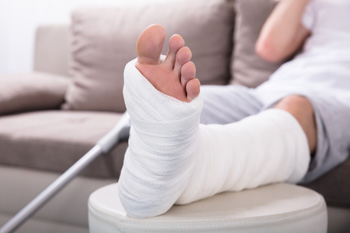 The foot is made up of 26 bones, so perhaps it comes as no surprise that foot fractures account for about 10% of all broken bones in the body. Foot fractures are some of the most common podiatric injuries, particularly among athletes. A broken foot bone can be especially debilitating, as the feet carry the weight of the whole body. The symptoms of a broken foot include pain, bruising, swelling, and tenderness, as well as difficulty standing or walking. The extent of your symptoms will depend on the type of fracture and its severity. A stress fracture, which is characterized by tiny cracks in the affected bone, may be less painful than a full fracture, in which a bone breaks completely. If you suspect that you may have a broken bone in your foot, please seek the care of a podiatrist.
The foot is made up of 26 bones, so perhaps it comes as no surprise that foot fractures account for about 10% of all broken bones in the body. Foot fractures are some of the most common podiatric injuries, particularly among athletes. A broken foot bone can be especially debilitating, as the feet carry the weight of the whole body. The symptoms of a broken foot include pain, bruising, swelling, and tenderness, as well as difficulty standing or walking. The extent of your symptoms will depend on the type of fracture and its severity. A stress fracture, which is characterized by tiny cracks in the affected bone, may be less painful than a full fracture, in which a bone breaks completely. If you suspect that you may have a broken bone in your foot, please seek the care of a podiatrist.
A broken foot requires immediate medical attention and treatment. If you need your feet checked, contact Elliot T. Udell, DPM from New York. Our doctor can provide the care you need to keep you pain-free and on your feet.
Broken Foot Causes, Symptoms, and Treatment
A broken foot is caused by one of the bones in the foot typically breaking when bended, crushed, or stretched beyond its natural capabilities. Usually the location of the fracture indicates how the break occurred, whether it was through an object, fall, or any other type of injury.
Common Symptoms of Broken Feet:
- Bruising
- Pain
- Redness
- Swelling
- Blue in color
- Numbness
- Cold
- Misshapen
- Cuts
- Deformities
Those that suspect they have a broken foot shoot seek urgent medical attention where a medical professional could diagnose the severity.
Treatment for broken bones varies depending on the cause, severity and location. Some will require the use of splints, casts or crutches while others could even involve surgery to repair the broken bones. Personal care includes the use of ice and keeping the foot stabilized and elevated.
If you have any questions please feel free to contact our office located in Hicksville, NY . We offer the newest diagnostic and treatment technologies for all your foot and ankle needs.
Are Bunions Affecting Your Everyday Life?
Types of Peripheral Artery Disease
Peripheral artery disease (PAD) is a condition characterized by reduced blood flow to the lower limbs. This can cause symptoms such as leg cramps, pain, fatigue, numbness, skin discoloration, and foot wounds. There are two types of PAD. Occlusive PAD occurs when the blood vessels are blocked. This can be caused by the arteries thickening and hardening over time (atherosclerosis), an excess buildup of lymph fluid (lymphedema), blood clots forming in the veins of the leg muscles (deep vein thrombosis), or narrowed carotid arteries (carotid artery stenosis). Functional PAD occurs when the blood vessels are not blocked, but rather malfunctioning due to spasms. This can be seen in cases of varicose veins, Raynaud’s disease, and chronic venous insufficiency. Functional PAD is typically made worse or triggered by environmental or lifestyle factors, such as exposure to cold, excessive stress, and smoking. If you are experiencing any symptoms of PAD, it is suggested that you see a podiatrist.
Poor circulation is a serious condition and needs immediate medical attention. If you have any concerns with poor circulation in your feet contact Elliot T. Udell, DPM of New York. Our doctor will treat your foot and ankle needs.
Poor Circulation in the Feet
Poor blood circulation in the feet and legs is can be caused by peripheral artery disease (PAD), which is the result of a buildup of plaque in the arteries.
Plaque buildup or atherosclerosis results from excess calcium and cholesterol in the bloodstream. This can restrict the amount of blood which can flow through the arteries. Poor blood circulation in the feet and legs are sometimes caused by inflammation in the blood vessels, known as vasculitis.
Causes
Lack of oxygen and oxygen from poor blood circulation restricts muscle growth and development. It can also cause:
- Muscle pain, stiffness, or weakness
- Numbness or cramping in the legs
- Skin discoloration
- Slower nail & hair growth
- Erectile dysfunction
Those who have diabetes or smoke are at greatest risk for poor circulation, as are those who are over 50. If you have poor circulation in the feet and legs it may be caused by PAD and is important to make changes to your lifestyle in order to reduce risk of getting a heart attack or stroke. Exercise and maintaining a healthy lifestyle will dramatically improve conditions.
As always, see a podiatrist as he or she will assist in finding a regimen that suits you. A podiatrist can also prescribe you any needed medication.
If you have any questions please feel free to contact our office located in Hicksville, NY . We offer the newest diagnostic and treatment technologies for all your foot and ankle needs.
Potential Sources of Heel Pain
 Heel pain can be debilitating, and it can develop due to a variety of causes. While it is most common among seniors, heel pain can occur at any age. The most common cause of heel pain is plantar fasciitis. This occurs when the plantar fascia, the tissues that connect the heel to the toes along the bottom of the foot, becomes inflamed. This causes the tissues to pull on and ultimately stress the heel. Plantar fasciitis can also lead to heel spurs. These occur when there are calcium deposits on the bottom of the heel bone that protrude out. Another common cause of heel pain is atrophy of the fat pad on the heel. Children, especially if they are active, who are suffering from heel pain may have Sever’s disease. This occurs when the bones in the calves grow faster than the Achilles tendon, which connects the heel bone to the calf muscle. If you are suffering from heel pain that won’t subside, consult with a podiatrist for a proper diagnosis and treatment method.
Heel pain can be debilitating, and it can develop due to a variety of causes. While it is most common among seniors, heel pain can occur at any age. The most common cause of heel pain is plantar fasciitis. This occurs when the plantar fascia, the tissues that connect the heel to the toes along the bottom of the foot, becomes inflamed. This causes the tissues to pull on and ultimately stress the heel. Plantar fasciitis can also lead to heel spurs. These occur when there are calcium deposits on the bottom of the heel bone that protrude out. Another common cause of heel pain is atrophy of the fat pad on the heel. Children, especially if they are active, who are suffering from heel pain may have Sever’s disease. This occurs when the bones in the calves grow faster than the Achilles tendon, which connects the heel bone to the calf muscle. If you are suffering from heel pain that won’t subside, consult with a podiatrist for a proper diagnosis and treatment method.
Many people suffer from bouts of heel pain. For more information, contact Elliot T. Udell, DPM of New York. Our doctor can provide the care you need to keep you pain-free and on your feet.
Causes of Heel Pain
Heel pain is often associated with plantar fasciitis. The plantar fascia is a band of tissues that extends along the bottom of the foot. A rip or tear in this ligament can cause inflammation of the tissue.
Achilles tendonitis is another cause of heel pain. Inflammation of the Achilles tendon will cause pain from fractures and muscle tearing. Lack of flexibility is also another symptom.
Heel spurs are another cause of pain. When the tissues of the plantar fascia undergo a great deal of stress, it can lead to ligament separation from the heel bone, causing heel spurs.
Why Might Heel Pain Occur?
- Wearing ill-fitting shoes
- Wearing non-supportive shoes
- Weight change
- Excessive running
Treatments
Heel pain should be treated as soon as possible for immediate results. Keeping your feet in a stress-free environment will help. If you suffer from Achilles tendonitis or plantar fasciitis, applying ice will reduce the swelling. Stretching before an exercise like running will help the muscles. Using all these tips will help make heel pain a condition of the past.
If you have any questions please contact our office located in Hicksville, NY . We offer the newest diagnostic and treatment technologies for all your foot and ankle needs.
More...
How Common Is Peripheral Artery Disease?
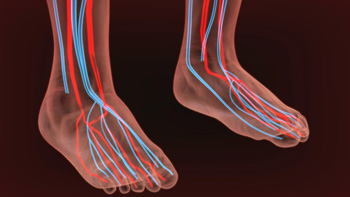 Peripheral artery disease (PAD) is a condition in which the arteries that supply blood to your limbs become narrow and hardened due to a buildup of plaque along the artery walls, leading to poor circulation. This condition is unfortunately quite common, affecting up to 200 million people worldwide. Often, people are not even aware that they have PAD because it does not always produce noticeable symptoms. When symptoms are apparent, they may include pain, cramping, tightness, or fatigue in the lower limbs. These symptoms often become worse with exercise or physical exertion. More advanced PAD can cause pain in the legs even without physical activity, as well as numbness, coldness, and discoloration of the lower limbs. In some cases, wounds that heal poorly may appear on the feet and legs. If you are experiencing any of the symptoms of PAD, or if you are older and at risk of developing this condition, please seek the care of a podiatrist.
Peripheral artery disease (PAD) is a condition in which the arteries that supply blood to your limbs become narrow and hardened due to a buildup of plaque along the artery walls, leading to poor circulation. This condition is unfortunately quite common, affecting up to 200 million people worldwide. Often, people are not even aware that they have PAD because it does not always produce noticeable symptoms. When symptoms are apparent, they may include pain, cramping, tightness, or fatigue in the lower limbs. These symptoms often become worse with exercise or physical exertion. More advanced PAD can cause pain in the legs even without physical activity, as well as numbness, coldness, and discoloration of the lower limbs. In some cases, wounds that heal poorly may appear on the feet and legs. If you are experiencing any of the symptoms of PAD, or if you are older and at risk of developing this condition, please seek the care of a podiatrist.
Peripheral artery disease can pose a serious risk to your health. It can increase the risk of stroke and heart attack. If you have symptoms of peripheral artery disease, consult with Elliot T. Udell, DPM from New York. Our doctor will assess your condition and provide you with quality foot and ankle treatment.
Peripheral artery disease (PAD) is when arteries are constricted due to plaque (fatty deposits) build-up. This results in less blood flow to the legs and other extremities. The main cause of PAD is atherosclerosis, in which plaque builds up in the arteries.
Symptoms
Symptoms of PAD include:
- Claudication (leg pain from walking)
- Numbness in legs
- Decrease in growth of leg hair and toenails
- Paleness of the skin
- Erectile dysfunction
- Sores and wounds on legs and feet that won’t heal
- Coldness in one leg
It is important to note that a majority of individuals never show any symptoms of PAD.
Diagnosis
While PAD occurs in the legs and arteries, Podiatrists can diagnose PAD. Podiatrists utilize a test called an ankle-brachial index (ABI). An ABI test compares blood pressure in your arm to you ankle to see if any abnormality occurs. Ultrasound and imaging devices may also be used.
Treatment
Fortunately, lifestyle changes such as maintaining a healthy diet, exercising, managing cholesterol and blood sugar levels, and quitting smoking, can all treat PAD. Medications that prevent clots from occurring can be prescribed. Finally, in some cases, surgery may be recommended.
If you have any questions, please feel free to contact our office located in Hicksville, NY . We offer the newest diagnostic and treatment technologies for all your foot care needs.
What Are the Causes and Risk Factors of Developing Gout?
Purine, a chemical compound, is naturally present in the body and in foods including certain meats and seafood, as well as alcohol. When purine is broken down, uric acid is produced. If the body cannot properly flush uric acid out, it may crystalize in the joints—causing inflammation, pain, stiffness and even deformity in extreme cases. This condition, known as gout, is a form of arthritis which most commonly occurs in the metatarsophalangeal joint connecting the foot with the big toe. Men are more likely to develop gout, as well as people with a family history of gout, or those who are over 50 years old. Other risk factors can include obesity, high blood pressure, abnormal kidney functions, and drug or alcohol abuse. In rare cases, children with certain genetic disorders that cause an excess of uric acid can develop gout. If you are in any of these high-risk groups and are experiencing pain or inflammation in any ankle or foot joint, contact a podiatrist who can examine you and may perform tests to analyze the fluid around the joint to see if uric acid crystals are present.
Gout is a painful condition that can be treated. If you are seeking treatment, contact Elliot T. Udell, DPM from New York. Our doctor will treat your foot and ankle needs.
What Is Gout?
Gout is a form of arthritis that is characterized by sudden, severe attacks of pain, redness, and tenderness in the joints. The condition usually affects the joint at the base of the big toe. A gout attack can occur at any random time, such as the middle of the night while you are asleep.
Symptoms
- Intense Joint Pain - Usually around the large joint of your big toe, and it most severe within the first four to twelve hours
- Lingering Discomfort - Joint discomfort may last from a few days to a few weeks
- Inflammation and Redness -Affected joints may become swollen, tender, warm and red
- Limited Range of Motion - May experience a decrease in joint mobility
Risk Factors
- Genetics - If family members have gout, you’re more likely to have it
- Medications - Diuretic medications can raise uric acid levels
- Gender/Age - Gout is more common in men until the age of 60. It is believed that estrogen protects women until that point
- Diet - Eating red meat and shellfish increases your risk
- Alcohol - Having more than two alcoholic drinks per day increases your risk
- Obesity - Obese people are at a higher risk for gout
Prior to visiting your podiatrist to receive treatment for gout, there are a few things you should do beforehand. If you have gout you should write down your symptoms--including when they started and how often you experience them, important medical information you may have, and any questions you may have. Writing down these three things will help your podiatrist in assessing your specific situation so that he or she may provide the best route of treatment for you.
If you have any questions, please feel free to contact our office located in Hicksville, NY . We offer the newest diagnostic and treatment technologies for all your foot care needs.
Types of Achilles Tendon Injuries
 The Achilles tendon is the band located on the back of the leg and is responsible for connecting the calf to the heel bone. This tendon is responsible for allowing us to rise up on our toes and for us to push off when walking or running. There are 2 main types of injuries that can occur to the Achilles tendon. The first, known as Achilles tendinopathy, occurs when there are tiny tears in the tendon and around it, usually from overuse. The second injury, an Achilles tendon rupture, can cause sudden pain and loss of movement. This is usually caused by a sudden movement or force that stresses the calf muscle. Patients who are experiencing pain in their Achilles tendon should consult with a podiatrist because of the potential severity these injuries have. A podiatrist will examine the leg and determine the extent of the injury.
The Achilles tendon is the band located on the back of the leg and is responsible for connecting the calf to the heel bone. This tendon is responsible for allowing us to rise up on our toes and for us to push off when walking or running. There are 2 main types of injuries that can occur to the Achilles tendon. The first, known as Achilles tendinopathy, occurs when there are tiny tears in the tendon and around it, usually from overuse. The second injury, an Achilles tendon rupture, can cause sudden pain and loss of movement. This is usually caused by a sudden movement or force that stresses the calf muscle. Patients who are experiencing pain in their Achilles tendon should consult with a podiatrist because of the potential severity these injuries have. A podiatrist will examine the leg and determine the extent of the injury.
Achilles tendon injuries need immediate attention to avoid future complications. If you have any concerns, contact Elliot T. Udell, DPM of New York. Our doctor can provide the care you need to keep you pain-free and on your feet.
What Is the Achilles Tendon?
The Achilles tendon is a tendon that connects the lower leg muscles and calf to the heel of the foot. It is the strongest tendon in the human body and is essential for making movement possible. Because this tendon is such an integral part of the body, any injuries to it can create immense difficulties and should immediately be presented to a doctor.
What Are the Symptoms of an Achilles Tendon Injury?
There are various types of injuries that can affect the Achilles tendon. The two most common injuries are Achilles tendinitis and ruptures of the tendon.
Achilles Tendinitis Symptoms
- Inflammation
- Dull to severe pain
- Increased blood flow to the tendon
- Thickening of the tendon
Rupture Symptoms
- Extreme pain and swelling in the foot
- Total immobility
Treatment and Prevention
Achilles tendon injuries are diagnosed by a thorough physical evaluation, which can include an MRI. Treatment involves rest, physical therapy, and in some cases, surgery. However, various preventative measures can be taken to avoid these injuries, such as:
- Thorough stretching of the tendon before and after exercise
- Strengthening exercises like calf raises, squats, leg curls, leg extensions, leg raises, lunges, and leg presses
If you have any questions please feel free to contact our office located in Hicksville, NY . We offer the newest diagnostic tools and technology to treat your foot and ankle needs.
